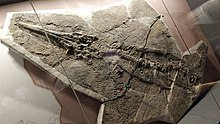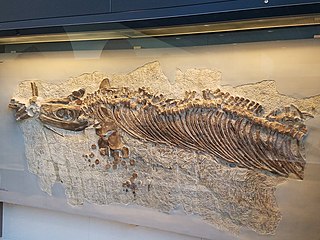
Cymbospondylus is an extinct genus of large ichthyosaurs, of which it is among the oldest representatives, that lived during the Anisian stage of the Middle Triassic in what are now North America and Europe. The first known fossils of this taxon are a set of more or less complete vertebrae which were discovered in the 19th century in various mountain ranges of Nevada, in the United States, before being named and described by Joseph Leidy in 1868. It is in the beginning of the 20th century that more complete fossils were discovered through several expeditions launched by the University of California, and described in more detail by John Campbell Merriam in 1908, thus visualizing the overall anatomy of the animal. While many species have been assigned to the genus, only five are recognized as valid, the others being considered synonymous, doubtful or belonging to other genera. Cymbospondylus was formerly classified as a representative of the Shastasauridae, but more recent studies consider it to be more basal, view as the type genus of the Cymbospondylidae.
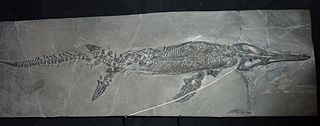
Mixosaurus is an extinct genus of Middle Triassic ichthyosaur. Its fossils have been found near the Italy–Switzerland border and in South China.
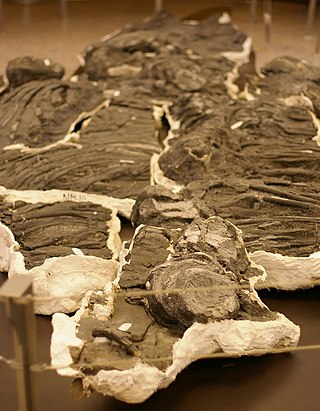
Shastasauridae is an extinct family of Triassic ichthyosaurs. The family contains the largest known species of ichthyosaurs, which include some of and possibly the largest known marine reptiles.
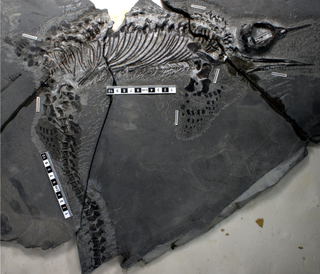
Chaohusaurus is an extinct genus of basal ichthyopterygian, depending on definition possibly ichthyosaur, from the Early Triassic of Chaohu and Yuanan, China.
Californosaurus is an extinct genus of ichthyosaur, an extinct marine reptile, from the Lower Hosselkus Limestone of California, and also the Muschelkalk of Germany.

Shastasaurus is an extinct genus of ichthyosaur from the Late Triassic. Specimens have been found in the United States, Canada, and China.
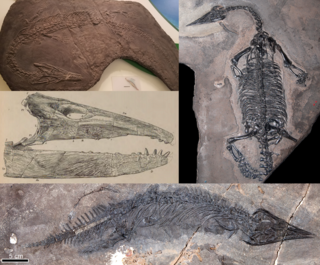
Thalattosauria is an extinct order of prehistoric marine reptiles that lived in the Middle to Late Triassic. Thalattosaurs were diverse in size and shape, and are divided into two superfamilies: Askeptosauroidea and Thalattosauroidea. Askeptosauroids were endemic to the Tethys Ocean, their fossils have been found in Europe and China, and they were likely semiaquatic fish eaters with straight snouts and decent terrestrial abilities. Thalattosauroids were more specialized for aquatic life and most had unusual downturned snouts and crushing dentition. Thalattosauroids lived along the coasts of both Panthalassa and the Tethys Ocean, and were most diverse in China and western North America. The largest species of thalattosaurs grew to over 4 meters (13 feet) in length, including a long, flattened tail utilized in underwater propulsion. Although thalattosaurs bore a superficial resemblance to lizards, their exact relationships are unresolved. They are widely accepted as diapsids, but experts have variously placed them on the reptile family tree among Lepidosauromorpha, Archosauromorpha, ichthyosaurs, and/or other marine reptiles.
Callawayia is an extinct genus of ichthyosaur. It contains the species Callawayia neoscapularis.

Qianichthyosaurus is an extinct genus of ichthyosaur from the Ladinian and Carnian stages of the Late Triassic epoch. Its fossils have been found in southeastern China, in Carnian rocks of the Falang Formation near Huangtutang, Guizhou. The type species is Qianichthyosaurus zhoui, named by Chun Li in 1999. A second species, Qianichthyosaurus xingyiensis, was named from older (Ladinian) deposits in the Falang Formation in 2013 by Pengfei Yang and colleagues. Complete Qianichthyosaurus fossils are common in the Xiaowa Formation, with both juveniles and pregnant specimens being known; its larger contemporaries, Guizhouichthyosaurus and Guanlingsaurus, are rarer.

Thaisaurus is an extinct genus of ichthyopterygian marine reptile that lived during the Spathian. Fossils have been found in Thailand.
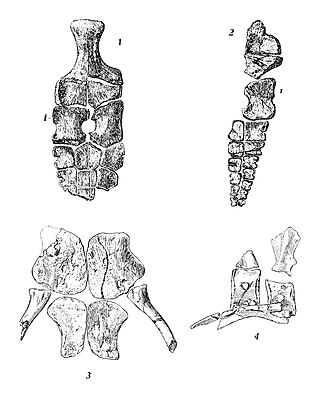
Toretocnemus is an extinct genus of ichthyosaur. Its remains have been found in California, United States, in Triassic layers of the Carnian Hosselkus Limestone.
Wimanius is a genus of ichthyosaur from the Middle Triassic of Switzerland, containing a single species, Wimanius odontopalatus. It was described by Michael Maisch and Andreas Matzke in 1998 based on an incomplete skull from Monte San Giorgio, a mountain on the Swiss-Italian border. Wimanius possesses teeth on its palate, though whether they were located on the palatine or pterygoid is disputed. Other features of Wimanius include a large orbit and jugals with two rami of similar lengths. Different phylogenetic placements of Wimanius have been recovered by different studies, including it being a mixosaurid relative or a merriamosaur, and a monotypic family, Wimaniidae has been named for it. However, its validity has also been questioned, and synonymy with various other genera has been proposed. The only specimen of Wimanius come from the Besano Formation. During the Anisian, this region was a lagoon populated by a wide variety of marine life, including a variety of other ichthyosaurs.

Anshunsaurus is a genus of thalattosaurs within the family Askeptosauridae. Fossils have been found from Middle Triassic deposits in Guizhou, China. Three species are known: the type species A. huangguoshuensis, the slightly older species A. wushaensis, and the species A. huangnihensis.
Guanlingsaurus is an extinct genus of shastasaurid ichthyosaur from the Late Triassic of China. It grew up to 8.3 metres (27 ft) in length and has a wide, triangular skull with a short and toothless snout.

Thalattoarchon is a genus of large, Middle Triassic predatory ichthyosaur from North America, containing the single species T. saurophagis. The taxon was described in 2013 from a single specimen discovered in the Favret Formation in Nevada. The generic name, meaning "ruler of the seas", refers to its status as an apex predator, while the specific epithet, meaning "lizard eater", alludes to its carnivorous diet. The classification of this genus within the ichthyosaurs is much debated, being either classified within the clade Merriamosauria or in the more basal family Cymbospondylidae.
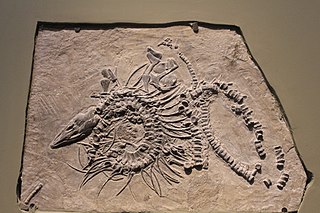
Xinpusaurus is an extinct genus of thalattosaur from the Late Triassic of Guanling in Guizhou, China. Several species have been named since 2000: the type species X. suni along with the species X. bamaolinensis and X. kohi. A 2013 study proposed that all three species are synonymous with each other, in which case X. suni would be the only valid species, although a 2014 study argued that X. kohi was also valid. A fourth species, X. xingyiensis, was described in 2016.
Xinminosaurus is an extinct genus of cymbospondylid ichthyosaur known from the Middle Triassic of Guizhou Province, China.

This timeline of ichthyosaur research is a chronological listing of events in the history of paleontology focused on the ichthyosauromorphs, a group of secondarily aquatic marine reptiles whose later members superficially resembled dolphins, sharks, or swordfish. Scientists have documented ichthyosaur fossils at least as far back as the late 17th century. At that time, a scholar named Edward Lhuyd published a book on British fossils that misattributed some ichthyosaur vertebrae to actual fishes; their true nature was not recognized until the 19th century. In 1811, a boy named Joseph Anning discovered the first ichthyosaur fossils that would come to be scientifically recognized as such. His sister Mary would later find the rest of its skeleton and would go on to become a respected fossil collector and paleontologist in her own right.
